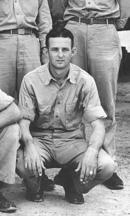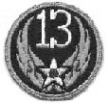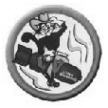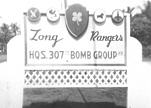|
(Information gathered from various web sites dedicated to the 13th Air Force, 307th Bomb Group. For more information, visit the 13th air force web site at http://www.enter.net/~rocketeer/13thmain.html)
The 307th Bombardment Group (Heavy) was activated in 1942 by the Army Air Corps Combat Command after an attack on Pearl Harbor thrust the United States in war with Japan. In succeeding years, the 307th's participation in World War II, the Korean Conflict and the Vietnam Conflict proved it to be one of the most renowned bombing units in military annals.
On April 15, 1942, the 307th began operations as a B-17 Flying Fortress bomber unit at Geiger Field, Washington. Its first mission to guard the northwestern United States and Alaskan coasts against armed invasion prepared the group for its later role in the Pacific Theater of World War II.
After patrolling the coastline of America for five months, the 307th's B-17s were replaced with the famous B-24 "Liberators". Subsequently, the entire unit was transferred to Sioux City, Iowa, for a brief training period. After completing a three-week familiarization program, the 307th relocated its entire cadre and 35 bombers to Hamilton Field, California.
Three days later, the B-24s were deployed to Oahu in the Hawaiian Islands. An old Norwegian freighter slowly transported the remainder of the group to its "Pacific Paradise". Upon arrival at Oahu, each of the group’s four squadrons was assigned to different Hawaiian locations; the 370th to Kipapa, the 371st to Wheeler Field, the 372nd to Kabuka and the 424th to Mokaleia. Headquarters for the 307th was centered at Hickam Field. Finally settled at Oahu, 307th bombers began search and patrol missions over the surrounding Pacific area. Mantaining a 24-hour vigil, the bombers were to avert any naval attack against the Hawaiian Islands. Stations were eventually set up on Espiritu Santo, New Hebrides on Jan 13, 1943; Guadalcanal, Solomon Islands on Aug 20, 1943; Los Negros, Admiralty Islands on Jun 1, 1944; Wake Island on Sep 3 ,1944; Morotai, New Guinea on Oct 17, 1944 and Clark Field, Luzon, Philippines on Aug 27, 1945.
Group bombers received their first taste of combat December 27, 1942. Twenty-seven of the group’s aircraft were deployed from Oahu to Midway Island. From here, the B-24s staged their first attack against an enemy fortress on Wake Island. The enemy was taken by surprise during the predawn raid. Before Japanese units responded with a barrage of anti-aircraft fire, 307th bombers had blasted 90 percent of the Wake stronghold. All aircraft returned safely from what was considered the longest mass raid of that time. (It was from this that the 307th Bomb Group became known as "the Long Rangers").
The 307th moved to Guadalcanal in February 1943. From their new location on the largest of the Solomon Islands, Group bombers attacked fortified Japanese airfields and shipping installations within the Southwest Pacific. At Guadalcanal, round support troops were subjected to massive air attacks by enemy bomber and fighter aircraft. On a warm day in March 1943, three waves of Japanese planes blasted the airfield, causing the greatest number of 307th casualties during the war.
November 11, 1945, the 307th participated in the largest aerial strike of the South Pacific War. In conjunction with United States naval elements, group bombers pounded enemy war and merchant ships at Rabaul, New Guinea. Amdist swarms of Japanese "Zeros" and heavy anti-aircraft fired, 307th aircraft released their bombs, leaving the port of Rabaul in complete ruin.
Throughout the remainder of the war, 307th aircraft continued to cripple the debilitated enemy. Group elements neutralized Japanese forces at Yap, Truk, and Palau islands. Bombing strikes against Japanese shipping centers in the Philippines inhibited the enemy from gaining a further strong hold in the area. An unescorted attack by group aircraft against oil refineries at Balikapan, Borneo, October 3, 1944 helped assure an allied victory in the South Pacific.
Following V-J Day, 1945, 307th aircraft ferried former American war prisoners from Okinawa to Manila. No longer needed, the group returned to the states in December 1945 and was subsequently deactivated. With barely time to form cobwebs, the 307th Bombardment Group was reactivated August 4, 1946, and is still active today.
While in the Pacific, the 307th was awarded two Distinguished Unit Citations, one for an air strike against Truk on March 29, 1944 and another for a strike against the refineries at Borneo on October 3, 1944. The group was also awarded the Philippine Presidential Unit Citation for its active role in the Philippines campaign.
|





























 PIN IT
PIN IT